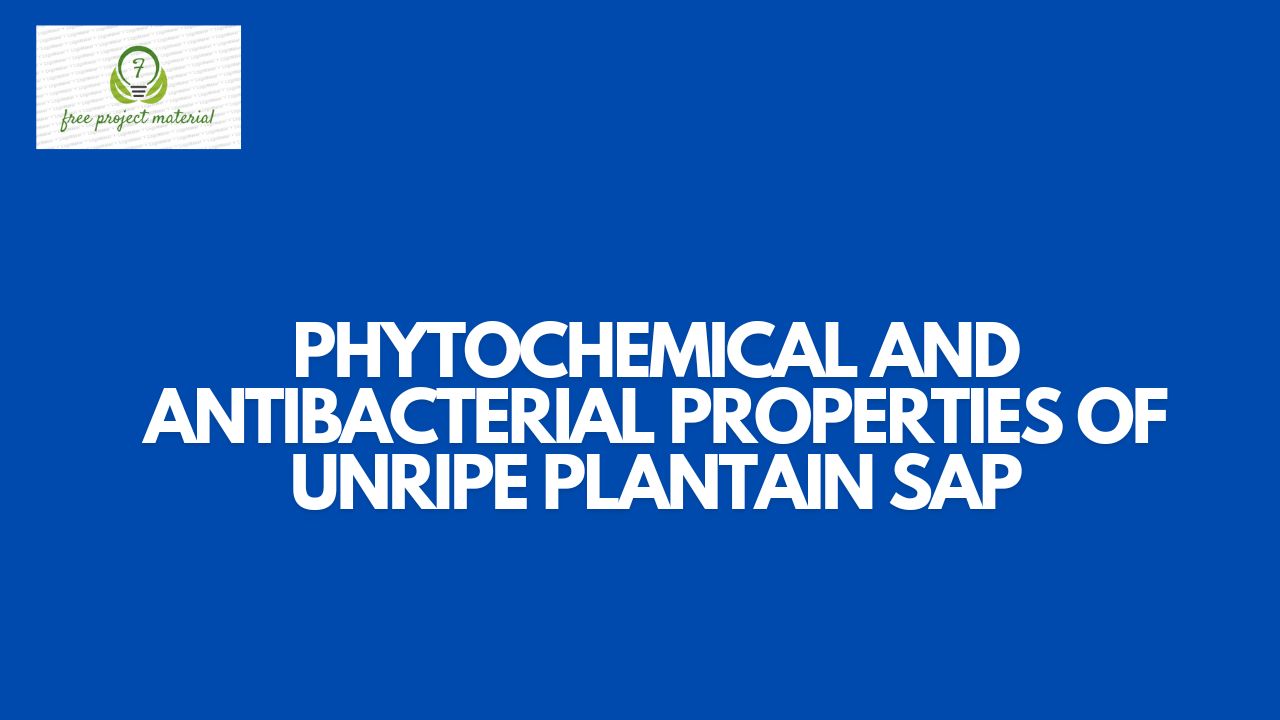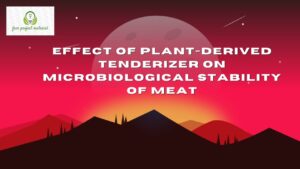ABSTRACT
This study was aimed at investigating the phytochemical composition and antibacterial activity of Musa paradisiaca sap. Standard analytical methods were employed to analyze the phytochemical composition of the sap, also asceptically approved techniques were utilized to examine the antibacterial activity of the plantain sap. The result of the phytochemical screening revealed that saponin, tannins, flavonoids, terpenes, phenol and cardiac glycoside were present in low (+) amount while alkaloid was in moderate (++) amount. The heterotrophic bacterial count revealed that stool sample A had the highest count of 2.5×105 cfu/g while the least was found in sample C with1.7×105. On the urine samples, sample A had the highest (1.90×104ml) and the least was found in sample C with 0.7×104 cfu/ml. The antibacterial activity of plantain sap revealed that Escherichia coli, Pseudomonas sp and Salmonella sp, were sensitive to the plantain sap with (22mm, 21mm and 20mm) respectively and resistant to other concentrations (i.e 80% and 50%) while Staphylococcus aureus was resistant to all the concentrations with (10.5mm, 12mm and 8m) for 100%, 80% and 50% respectively. Although the bacterial isolates was sensitive to ciprofloxacin, the antibacterial activity of plantain sap was comparable to those of ciprofloxacin (standard antibiotic). This result implies that plantain sap possesses antibacterial activity and therefore could be utilized in the pharmaceutical industries in the formulation of antibiotics. Furthermore, the consumption of plantain is encouraged due to the rich pharmacological constituents.
TABLE OF CONTENTS
Title page – – – – – – – – i
Certification – – – – – – – ii
Dedication – – – – – – – – iii
Acknowledgement – – – – – – – iv
Abstract – – – – – – – – v
Table of contents – – – – – – – vi-vii
CHAPTER ONE: INTRODUCTION
1.1 Background of the Study – – – – – – 1-4
1.2 Aim and Objectives of the Study – – – – 4
1.2.1 Aim of the Study – – – – – – – 4
1.2.2 Objectives of the Study – – – – – – 4
1.3 Scope and Limitation of the Study – – – – 4-5
CHAPTER TWO: LITERATURE REVIEW
2.1 Description and Distribution of plantain – – – 6-8
2.2 Antimicrobial properties of plantain – – – – 8-13
2.2.1 Reports of Antimicrobial Applications of
different plantain parts – – – – – – 14-16
2.3 Health Benefits of plantain sap – – – – – 16-17
2.4 Effect of extraction techniques and solvent on extract – 17-18
2.5 Health Importance of phytochemical – – – – 19
2.5.1 Flavonoid – – – – – – – – 19-21
2.5.2 Tannins – – – – – – – – 21
2.5.3 Alkaloids – – – – – – – – 22-23
2.5.4 Saponins – – – – – – – – 23-25
2.5.5 Cardiac Glycosides – – – – – – 25-26
CHAPTER THREE: MATERIALS AND METHODS
3.1 Materials – – – – – – – – 27
3.2 Sterilization of Glasswares and Media Preparation. – – 27
3.3 Sample Collection – – – – – – – 28
3.4 Extraction of Plantain Sap – – – – – 28
3.5 Bacteriological Analysis – – – – – 28
3.5.1 Cultivation of Microorganisms – – – – – 28-29
3.5.2 Enumeration of Bacterial Isolates – – – – 29
3.5.3 Purification of Bacterial Isolates – – – – 29
3.5.4 Characterization and Identification of Bacterial Isolates – 30
3.6 Antibacterial Susceptibility Test – – – – 30
3.6.1 Preparation of Antibiotic Sensitivity Disc – – – 30-31
3.6.2 Antibiotic Sensitivity Testing – – – – – 31
3.7 Phytochemical screening of Unripe plantain sap – – 31
CHAPTER FOUR: RESULT AND DISCUSSION
4.1 Result – – – – – – – – 32-38
4.2 Discussion – – – – – – – – 39-43
CHAPTER FIVE: CONCLUSION AND RECOMMENDATION
5.1 Conclusion – – – – – – – – 44
5.2 Recommendation – – – – – – – 44-45
References
CHAPTER ONE: INTRODUCTION
1.1 Background of the Study
Exudates are complex mixtures of organic compounds oozed by plants, often, but not always as a result of injury. These products are rich in carbon and hydrogen atoms and also commonly called “sap” although the word “sap” is used to describe any fluid that travels inside plants. In contrast, the word “exudate” refers to any such material when it is oozed out of the plant (Santiago-Blay and Lambert, 2010).
These plant products have been collected since about 3000BC, during the Egyptians civilization from Acacia and gum Arabic tress, native to North Africa and used as adhesive in hieroglyphic paints and in the embalming of Egyptian mummies. Nowadays, known exudates are employed as ingredients in medicines, cosmetics, perfumes, industrial and food product (Wolf, 2005; Hulse, 2006).
In developing countries, plants exudates are used in traditional medicine, for example, a good percentage of the populations depend on medicines made from trees for their primary health-care needs (Joy et al., 1998; FAO, 2004).
Musa paradisiaca L is evergreen tropical monoherbacious plant belonging to the family Musaceae (Paul et al., 2013; Sanjeev et al., 2012) commonly known as Vana laxmi, kadali, rambha, banana,kadakmu, velei, vala, bali hannu and plantain (Mohammad and Saleha, 2011).
Taxonomically plant belong to kingdom plantae, division Magnoliophyta, class Liliopsida, order zingiberales, family Musaceae, Genus Musa and special paradisiacal (Shodehunde et al., 2012). It is major food group in the humid and sub-humid parts of Pakistan, Africa, India, Burma, America and Australia and cultivated in Florida, Egypt, South Brazil and Bangladesh (Swathu et al., 2011).
Plant is up to 9m (10-40 feet) long with Pseudo stem, a crown of large elongated oval deep-green leaves (up to 365cm in length and 61cm in width) that grows through hollow stem with a prominent midrib each plant produces a single inflorescence like drooping spike and large bracts opening in succession, ovale, 15-20cm long, concalle, dark red colour and is somewhat fleshy. Fruits are oblong, fleshly, 5-7cm long in wild form and longer in the cultivated varieties (Sanjeal et al., 2012; Mohammad and Salcha 2011; Swathi et al., 2011). It contains starch, protein, fat, dietary fibre and is a source of vitamins A, B1, B2, B3, B6, C (Shodchinde et al., 2012). Vitamin E, β-carotene and minerals such as calcium, potassium and phosphorus along with alkaloids, glycosides, saponins, and steroids (Paul et al., 2013; Sidiqat and Ganiyo, 2013; Enye et al., 2013). Waste of pseude stem contains Na, K, Cr, Mg, Zn, Fe, Cu, and P (Akpabio et al., 2012). The peel and pulp of M. paradisiace L are reported to possess cellulose, hemicelluloses, leucine, valine, phenylalanine and threonine. The pulp protein is rich in arginine, aspartic acid, glutamic acid, methione and tryptophan. The flower contains tannins, saponins, reducing and non reducing sugars, sterols and triterpenes. High concentration of monomeric anthocyanin and rutinoside derivatives of ephinidin, pelargoniden, peonidine and malvidin are found in bracts. Fruit consists of carbohydrates, amino acids, sugar and starch, sitoindoside-1, sitoindoside-11, sitoindoside-111, sitoindiside-iv, sitosterol gentiobioside, sitosterol myoinositul-B-D-glucoside, nor epinephrine, serotonin, dopamine, tryptophan, indole compounds, iron, crystallisable and non-crystallisable sugars, vitamin C, B-vitamins, albuminoids, fats, mineral salts have been found in the fruit pulp of M. paradisiaea while fruit peel is rich in sitoindoside-IV and sitosterol myo-inositylbeta-D-glucoside (Mohammad and Saleha, 2011; Sanjeev et al., 2012).
1.2 Aim and Objectives of the Study
1.2.1 Aim
The aim of this study is to carry out the phytochemical and antibacterial screening of unripe plantain sap.
1.2.2 Objectives of the Study
The objectives of the study are;
- To determine the phytochemical properties of unripe plantain sap
- To carry out antibacterial screening of the plantain sap on some bacterial isolates.
1.3 Scope and Limitation of the Study
This scope of this study covers only the phytochemicals and Antibacteria properties of unripe plantain sap from Abiakpo Ntak Inyang in Ikot Ekpene Local Government Area Akwa Ibom State.
To purify and identity some bacterial species obtained from St Lukes Hospital, Awa.


